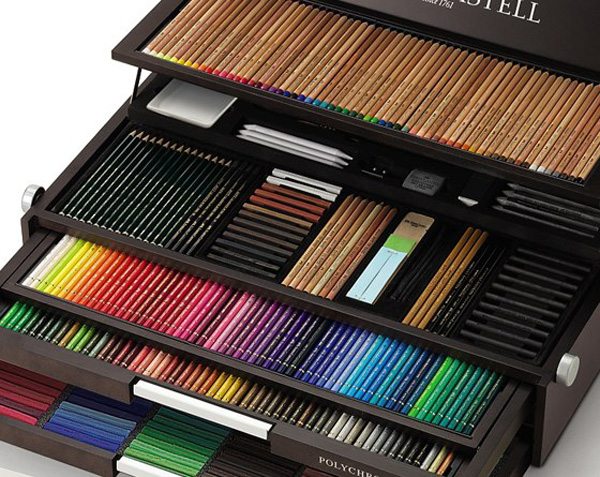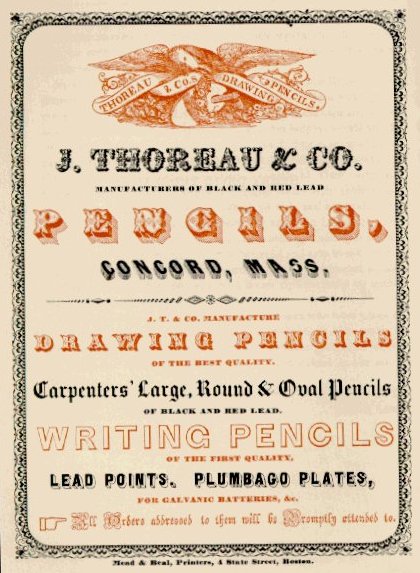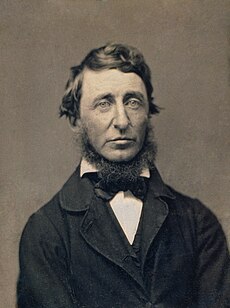I thought, after my entry on 666, that I ought to do something at the opposite end of the spectrum. What could be the opposite of fiery and dramatic and hysterical and murderous? Hmm. How about pencils. So, ladies and gentlemen, I give you the Number 2 Pencil.

The ever-present yellow #2 pencils.
(Photo from the Iqra Foundation)
Let's begin with the basics and then we'll progress to the more complicated questions.
Why, if the writing stuff inside pencils is graphite, do we call it "lead"?
- Partly because once upon a time, way way back in Roman times, the forerunner of the pencil, the stylus, was made of lead. But of course there is more to the story than that.
- In 1564, in Borrowdale, England, someone walked past a whole bunch of shiny black stuff stuck to the roots of a tree. I suppose its shininess made it look like it ought to be good for something, and after people played with it a while, they discovered it made dark marks on paper -- good for writing things down, they decided. Since it looked similar to lead, they called it "blacklead." (Some people called it plumbago, which is Latin meaning "lead ore.) Turned out, the stuff was graphite.
- Sidenote: Borrowdale happens to be in the Lake District. How fitting was it that graphite, a great tool for writing, was literally in the ground of the birthplace of some of Western literature's finest poetry?

Graphite mixed in with tree roots, as it was discovered in Borrowdale, England.
(Photo from the Museum of Everyday Life)
- Holding blacklead by itself was messy and hard to use, so people thought it would be easier to use if they put it inside some sort of holder. Hey, if you take a wooden stick, hollow it out, and fill it with blacklead, sort of like putting ink inside a quill, then you've really got something there! (That was the first pencil.)
- In 1796, a German mineralogist figured out that blacklead was a different substance than actual lead. So he called this stuff graphite. Which comes with the Greek graphein meaning "write." He was, in effect, saying, Hey, you can write with this!
- Thereafter, everybody knew that blacklead should be called graphite. But for whatever reason, when it was inside a pencil, they still called it lead. You know, people. So resistant to change.
- (By the way, Germany started mass-producing pencils in the 1600s. Faber-Castell, a name many artists will recognize, was founded in 1761 as one of those very early pencil-making companies.)

As the image says, this is the oldest known pencil encased in wood, from Faber-Castell.
(Photo from Pencils.com)

Faber-Castell 250th edition limited edition wooden case of pencils in 120 colors, plus watercolor pencils, pastel pencils, black-lead pencils, woodless graphite, compressed charcoal, and more. All this started in 1761, from lowly hunks of black stuff stuck in some tree roots.
(Photo from Extravaganzi)
Was Henry David Thoreau really a competitive pencil-making manufacturer in his day job?
- The short answer to this question is yes.
- (Test-taking hint: if they ask a complicated yes/no question, the answer is usually "yes." They wouldn't have asked it otherwise.)
- Now for the essay response.
- So, in the early 1800s, people in New England discovered that there was a whole lot of graphite thereabouts. Thus, many pencil-making businesses were founded in New England.
- One of those businesses, by the way, was the Joseph Dixon Crucible Company, founded in 1829 in Massachusetts. One of its graphite mills was located in Ticonderoga, NY. Thus today we have the omnipresent Dixon Ticonderoga pencils.

The Dixon Ticonderogas. These days, probably the most prevalent brand of No. 2 pencils in the US. This package is available from Amazon for about $10. Pre-Sharpened Pencil, #2, Yellow Barrel, 30/Pack - DIX13830
- Dixon's company was one of many pencil-makers in the early 1800s in New England. Another such company was John Thoreau & Company. John was Henry David's dad.

Broadside advertising J. Thoreau & Company Pencils, circa 1845.
(Image from the University of Florida George A. Smathers Libraries)
- Thoreau's pencil company was in Concord, New Hampshire. Another guy, David Munroe, had a pencil-making business of his own, also in Concord, New Hampshire. Munroe & Thoreau, being so geographically close and making the same product -- graphite pencils -- were therefore quite competitive.
- Munroe hired a cabinet-maker, Ebenezer Wood (yes, seriously, he was a cabinet-maker named Wood), to help him cut the cedar wood necessary to hold the graphite. Wood was also pretty inventive, and he figured out better and faster ways of producing the pencils.
- The way Munroe was making pencils was faster than hollowing out sticks of wood and jamming solid graphite in the middle, but it was still pretty labor-intensive. He basically made a graphite sandwich inside two slabs of cedar. Munroe took the graphite, ground it to a powder, and mixed it with glue. Meanwhile, he took the cedar wood, cut it into slabs to form a rectangular casing, hollowed out a trough in the casing, and then poured the graphite-glue mix into the trough. Then he put another hunk of cedar on top of the first, and sealed the two with a veneer. Once everything was dry, he cut the pencils out of the slab in a suitable size & shape.
- Wood made this whole process go faster. He was the first one to use a circular saw to cut the pencils out of the slab, and he also invented a machine that could mold & trim the pencils 12 gross at a time. He was also the first one to cut pencils in the octagon shape -- the same shape most pencils have today.
- All these innovations were a big deal. Faster, cheaper, better -- everybody a hard time competing with that. Thoreau and his dad were no exception.

Ebenezer Wood, inventor of many pencil-making processes that sped up the works, and a gadfly to the Thoreaus.
(Photo from Acton Conservation Lands)
- Although Ebenezer Wood was working & inventing for Munroe, he was also grinding the graphite in his mill for the Thoreaus as well as for Munroe. In an act of further competitiveness, Munroe tried to get Wood to stop grinding the Thoreaus' graphite. But he continued grinding the Thoreaus' graphite because, as it turned out, the Thoreaus had more customers and a bigger business than Munroe did.
- How did that happen? Enter Henry David.
- After graduating from Harvard, good old H.D.T. wanted to make a go of it as a writer & teacher, but it didn't go too well. So he went back home to his dad's pencil business. He worked part time, probably writing in his non-pencil-making off hours. But while he was doing his part-time-pencil-making, he came up with some pretty major inventions.
- He figured out how to inject the ground graphite goo directly into a hollowed-out pencil. With his innovation, none of that cedar-slab-making-and-cutting business was necessary. Sped up the process enormously, much faster than Wood's circular saw ever could. Thoreau also invented a machine that would grind the graphite to an especially fine powder.
- Not usually how you think of old "I went to the woods" Thoreau, is it? As an inventor of early industrial machinery? But that's what he was first.

Henry David Thoreau, civil disobedient, woods-goer, and transcendentalist, was first a pencil-maker and a machine-inventor.
(Daguerreotype by Benjamin D. Maxham from Wikipedia)
- In fact, Thoreau continued to work in the pencil-making business off and on for most of the rest of his adult life. A final nail in your coffin of innocence, I know.
- By the way, a lot of people are a little fast & loose with the facts, and they say that Thoreau came up with the idea of mixing poor-quality graphite with clay to make the ground graphite easier to work with and yield a better result at a lower cost. In fact, this process was first invented by a French guy named Nicholas-Jacque Conté in 1795. Thoreau's contribution to this process was to improve upon it a bit and to make it part of how his father's company made their pencil leads.
Are pencils rated on a scale of "hard" and "black"?
- Answer: yes. Porno-industry-like though that may seem.
- The reason for this rating has to do with that process we just learned about, that graphite and clay are mixed together to make the pencil lead.
- Sidenote: see, I'm still using that phrase "pencil lead." Because the core of the pencil, as we now know, is not entirely made of graphite. So it would also be erroneous to call it the "pencil graphite," or the "pencil clay." The easiest shorthand to refer to the entire inner core regardless of its mixture is to say "pencil lead."
- As you cooks and chemists might guess, the ratio of clay to graphite makes a difference in the kind of mark the pencil lead will make on the paper. Contrary to your expectations, the more clay, the harder the lead.
- It also makes a difference what kind of graphite you have. If you've got graphite from the Lake District in England, which is much harder and higher quality, it actually makes a lighter mark on the page. If you've got the New England Thoreau graphite which is softer and of poorer quality, it makes a darker mark.

Pencils with different ratios of graphite & clay make marks of varying degrees of lightness & darkness
(Image from Artmaker)
- So British pencil-makers came up with a system of indicating the hardness of the lead in the pencil. Hard was denoted with an H and soft was denoted with an
S-- no, a B. Huh? Since when does Soft = B?
- Since the softer leads produce a darker, or blacker mark. So Soft = Black which = B. Harder leads got HHs or HHHs, and the softest/darkest leads got BBs or BBBs.
- The midway point on this scale is
M-- no, it's F. Again, huh? Some people say the F means the lead can be sharpened to a finer point, but that makes no sense because there's no reason that lead should sharpen to a finer point than any other lead. Other people say there is no known logical reason for calling the midpoint F, and they leave it at that. So I will leave it at that too.
- Leave it to the British to complicate things. But wait, there's more.
- The British then decided they didn't like repeating all those Bs and Hs, so they put numbers in front of the Bs and Hs. There was no number to put in front of the F since it's the midpoint. Then, for reasons no one understands, they also added an HB (Hard-Black, apparently) which is just slightly darker than the F. So in the end there is no actual midpoint. And you get this:

How pencil leads are graded according to the British scale
(Image from The Almighty Guru)
- Do you feel us closing in on where Number 2 business comes from? We are, but wait, there's still more.
- So, you'll remember that Americans were making pencils, too. They decided they wanted a different scale for indicating the hardness/softness/blackness of their pencil leads. They decided they wanted to use strictly numbers. And their numbers would not exactly correspond with the numbers in the British scale.
- The American scale goes like this: 1, 2, 2½, 3, 4. It's like they were saying, "I'm going to count to five, young lady," and so they threw the 2½ in there. No, really, I don't know why the 2½.
- When you put the two scales together, you get this:

As you can see, the American #2 matches up with the British HB.
(Image from Jet Pens)
- So the Number 2 pencil that you used to take all those standardized tests in school was really the Hard Black pencil.
- You might be tempted to think that an HB pencil made by, say, Faber-Castell would be of the same darkness as a Number 2 pencil made by, say, Dixon. It would be lovely if that were the case. But it's not.
- This grading scale does not correspond to any kind of industry-wide manufacturing standard. The relative hardness/blackness of a company's pencils applies only to the company's own pencils. Thus an HB you get from Faber-Castell may not be of the same HB-ness as an HB from, say, Uni. So, serious pencil-purchasers are advised to try the pencils of various manufacturers to find the hardness/blackness they prefer.
So is the whole Everybody Must Have a Number 2 Pencil thing kind of a scam?
- Sort of, yes!
- Not all Number 2 pencils are equal. Since different manufacturers make their Number 2s to their own specifications, one company's Number 2 will be different than another's.
- The differences might be slight, but they are real.
- The point of everybody having to get a Number 2 pencil was that was the closest approximation the test-makers could get to making sure everybody had the same writing instrument.
- I want you to think about that for a minute and let that expand in your mind, especially in this era of standardized school testing. They can't even get everybody using the same kind of pencil lead. The best they can do is settle on an approximation.

Those of us taking standardized tests are not the same. Even down to our Number 2 pencils, we are different.
(Photo from New Futuro)
- Now seems like the right time to introduce the hotbed topic:
Was a pencil ever used as a murder weapon?
- (You know how to answer this) Yes.
- Most famously, when Julius Caesar was stabbed to death by members of the Senate, he tried to defend himself with the only weapon he had -- his stylus (a.k.a. pencil). He managed to stab Casca with it, but it wasn't enough of a blow, what with all those other guys with their knives, and he was killed.
- More obscurely, a priest and teacher from the times of early Christianity/Roman rule, Cassian of Imola (a.k.a. Cassianus) was arrested for being a Christian. He was told to renounce Christianity and he wouldn't do it, so his students "were invited to hack him to death." The weapons they used were their styluses (pencils). So it took a really long time for him to die.
- Talk about a violent classroom.

I guess the painter decided not to include the pencil in Caesar's other hand. Probably thought it too undignified.
(Image from History in the Headlines)
Bonus Question: Why are number 2 pencils yellow?
- When an Austro-Hungarian pencil-making company, the Hardtmuth Company introduced their fancy new pencils at the 1889 World's Fair in Paris, their pencils were painted yellow.
- The graphite in these pencils came from the Far East, and it was supposed to be the very best graphite in the world. So to enhance the fanciness of their pencils, they named them after the Koh-i-Noor diamond, a famous diamond in India and the height of luxury, and they painted the outside of the pencils yellow. Much fancier than the plain old bare cedar wood, these pencils were not only painted, but painted yellow, a color that was difficult to come by in paint in those days.
- Naturally, everyone copied the Hardtmuth Company. Soon everybody's pencils were painted yellow.
- So, once upon a time, your yellow Number 2 pencils would have been considered luxurious by their very yellow-ness.

Ah, a bouquet of yellow pencils! How lovely -- and how erstwhile decadent!
(Wallpaper of Bouquet of Pencils from IDMarching)
- Congratulations! You have reached the end of the test. Please put down your pencil to signal you have finished.
Sources
Mental Floss, What Makes #2 Pencils So Special?
The Straight Dope, How come you see #2 pencils but no #1 pencils?
Online Etymology Dictionary, graphite
Jennifer Schuessler, Thoreau's Pencil, The New York Times, May 1, 2009
Pencils.com, Pencil History and Pencil Myths: The Unleaded Pencil
Acton Conservation Land, Early American Pencils
The Museum of Everyday Life, A Visual History of the Pencil
Today in Science History, Joseph Dixon: The Story of a Lead Pencil
Dixon Corporation, Joseph Dixon 1799-1869
The Almighty Guru, Pencil Grades
Jet Pens, Picking the Perfect Pencil Lead Hardness Grade
Catholic Online, St. Cassian of Imola
New Advent, Classical Latin Literature in the Church
CBS Money Watch, Why Are Pencils Yellow?
Thanks for the fun bit of trivia! I do really like your blog - it's creative and different in a very good way. I pop in now and then and have even shared an entry or two on fb. I do like your new look, btw, but I liked the old look, too.
ReplyDeleteThanks, Unknown! I hope you've popped back in a few times since.
ReplyDelete